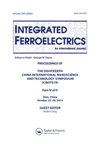Development of Flexible Semiconductors Based on g-C 3 N 4 /Cu 2 O P–N Heterojunction for Triboelectric Nanogenerator Application
IF 0.7
4区 工程技术
Q4 ENGINEERING, ELECTRICAL & ELECTRONIC
引用次数: 0
Abstract
AbstractThis research aims to develop flexible semiconductors for triboelectric nanogenerator (TENG) applications. The sample powders of graphitic carbon nitride (g-C3N4) and copper (I) oxide (Cu2O) as N-type and P-type semiconductors, respectively, were synthesized. The semiconductors were prepared to be a composite film with alginate. The structure, morphology, and purity of the N- and P-type semiconductors were characterized using X-Ray diffraction and scanning electron microscopy techniques. Through the optical characterization, the N-type semiconductor showed the calculated energy band gap of 2.80 eV, while the P-type semiconductor was 1.90 eV. The P–N junction property of prepared samples was confirmed using a nonlinear current–voltage characteristic. After that, two flexible semiconductors were frictional paired for TENG. Through a vertical contact-separation mode, the P–N junction-based TENG produced a maximum output voltage and current of 3.90 V and 0.44 µA, respectively, with a maximum output power of 0.35 µW at 10 MΩ. In summary, the present work achieved the preparation of flexible P- and N-type semiconductors. The feasibility to harvest the mechanical energy was demonstrated in the TENG configuration. This idea is crucial for the future development of flexible harvesting/sensing devices using a novel concept.Keywords: P-type semiconductorN-type semiconductorP–N Junctiontriboelectric nanogenerator Disclosure StatementNo potential conflict of interest was reported by the author(s).Additional informationFundingThis work was supported by KMITL under the Grant number KREF156601.The work of Supakarn Worathat thanks to funding support from the Faculty of Science, King Mongkut’s Institute of Technology Ladkrabang (KMITL) under Grant no. RA/TA 2565-M-001. The work of S. Sriphan was funded by King Mongkut’s University of Technology North Bangkok, Contract no. KMUTNB-65-KNOW-05.基于g- c3n4 / cu2o - P-N异质结的摩擦电纳米发电机柔性半导体的研制
摘要本研究旨在开发用于摩擦电纳米发电机(TENG)的柔性半导体。分别制备了n型和p型半导体的石墨化氮化碳(g-C3N4)和氧化铜(Cu2O)样品粉末。将半导体与海藻酸盐制备成复合薄膜。利用x射线衍射和扫描电镜技术对N型和p型半导体的结构、形态和纯度进行了表征。通过光学表征,n型半导体的计算能带隙为2.80 eV, p型半导体的计算能带隙为1.90 eV。利用非线性电流-电压特性证实了所制备样品的pn结性质。然后,将两个柔性半导体摩擦配对用于TENG。通过垂直触点分离模式,基于P-N结的TENG在10 MΩ时的最大输出电压和电流分别为3.90 V和0.44µa,最大输出功率为0.35µW。综上所述,本工作实现了柔性P型和n型半导体的制备。在TENG结构中验证了获取机械能的可行性。这一想法对于使用新概念的柔性收获/传感设备的未来发展至关重要。关键词:p型半导体- n型半导体- n结摩擦纳米发电机披露声明作者未报告潜在利益冲突。本研究由KMITL资助,授权号为KREF156601。Supakarn wora的工作得到了蒙古库特国王理工学院(KMITL)科学学院的资助,资助项目为:RA 2565 - m - 001 /助教。S. Sriphan的工作由King Mongkut 's University of Technology North Bangkok资助,合约编号:kmutnb - 65 - 05。
本文章由计算机程序翻译,如有差异,请以英文原文为准。
求助全文
约1分钟内获得全文
求助全文
来源期刊

Integrated Ferroelectrics
工程技术-工程:电子与电气
CiteScore
1.40
自引率
0.00%
发文量
179
审稿时长
3 months
期刊介绍:
Integrated Ferroelectrics provides an international, interdisciplinary forum for electronic engineers and physicists as well as process and systems engineers, ceramicists, and chemists who are involved in research, design, development, manufacturing and utilization of integrated ferroelectric devices. Such devices unite ferroelectric films and semiconductor integrated circuit chips. The result is a new family of electronic devices, which combine the unique nonvolatile memory, pyroelectric, piezoelectric, photorefractive, radiation-hard, acoustic and/or dielectric properties of ferroelectric materials with the dynamic memory, logic and/or amplification properties and miniaturization and low-cost advantages of semiconductor i.c. technology.
 求助内容:
求助内容: 应助结果提醒方式:
应助结果提醒方式:


